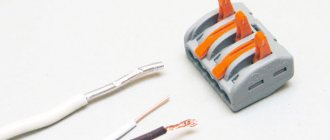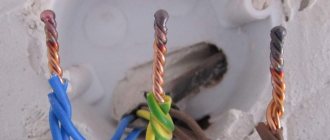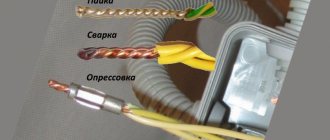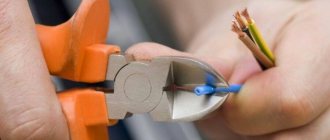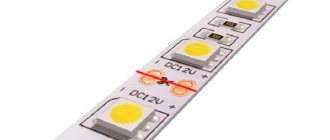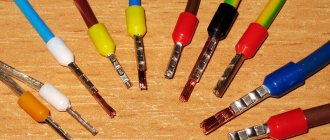Despite the fact that in modern construction, during electrical work, aluminum cables are increasingly being replaced by copper cables, aluminum remains an indispensable material in the manufacture of large-section wires and cables.
The reasons for this lie on the surface - the electrical resistivity of aluminum is approximately one and a half times greater than that of copper, and the volumetric weight is three times less.
With a large conductor cross-section, when weight is more important than strength, the choice in favor of aluminum is obvious. The cross-sectional area of an aluminum conductor will be one and a half times greater than that of a copper conductor, and at the same time, aluminum will still be two times lighter than copper. Soldering, among other methods, is used to connect wires.
Soldering methods
The problem with using aluminum conductors is their rapid oxidation.
The oxide film significantly impedes the passage of electric current during connections. To do this, twisted aluminum wires are soldered. You can solder aluminum wires in a junction box using a soldering iron or a gas torch. It is more difficult to use a soldering iron due to the inability to accurately heat to the required temperature. And for aluminum, overheating is just as unacceptable as underheating.
Metal has high thermal conductivity, and the insulation over a large area from the soldering point can simply melt.
It is easier to regulate the heating temperature with a gas burner, but it takes a long time to prepare the surface. However, it is the torch that will need to be used if it is necessary to solder any massive parts to each other. In any case, when soldering aluminum wires, they need to be prepared.
Difficulties in soldering aluminum wires
In addition to the oxide film and the lack of visual control over the heating temperature of the metal, there are several other difficulties. Soldering aluminum single-core wires should be carried out in just a few seconds so as not to damage the wire itself. The temperature effect on aluminum changes the structure of the metal, as a result of which it loses its strength and flexibility.
Soldering aluminum with a soldering iron at home
Almost all procedures, regardless of what type of soldering is used, must undergo a full range of preparatory procedures, which includes tinning, fluxing and stripping. It is precisely such procedures that help eliminate the oxide film, due to which the bulk of soldering defects are obtained. Another difficulty is the correct choice of parameters, since discounts with thin elements require a delicate approach. At the same time, the small thickness of the products helps to easily produce everything at home without any obvious loss of quality.
Methods for soldering aluminum wires
Soldering aluminum wires at home can be done in several ways. One of the main ones is soldering aluminum wires with a soldering iron, as this is one of the simplest and most common tools that is found in every home. It is enough to select a soldering iron of the required power to melt the solder and make the connection. Unlike other methods, it is the easiest to prepare, but requires that there be a source of electricity nearby. Unlike a torch, a soldering iron is a more crude method, so it may not be suitable for working with materials that are too thin.
Soldering aluminum with a soldering iron
The method using a burner, which can be gas or gasoline, helps to carry out more delicate procedures, since it is easier to regulate the temperature and the gas perfectly warms up not only the wire and solder itself, but also the areas that are located next to them. Preparing the burner is a longer procedure, since it needs to be refueled, the mode selected, and so on. This is also a less safe option, but after all, you don’t need to wait until the tool cools down for a long time, as happens when working with a soldering iron.
Soldering aluminum wires with a torch
Preparation for soldering
Regardless of whether aluminum wires are soldered with copper wires, or with the same ones as them, you should take the preparation responsibly, since the success of the operation depends on this. First of all, you need to clean the surface, which helps remove the oxide film. For the wires, fine-grit sandpaper or something similar will work. After this, you should tin the end of the wire that will be soldered and, if everything is done using a soldering iron, you should also tin the soldering iron tip. Despite the problematic use of some types of flux, metal shavings of solder or some liquid options can be used as a substitute, which will improve mixability and increase the joining speed.
Preliminary processing
Another factor that makes soldering aluminum wires difficult is rapid oxidation in air.
The oxide film on the surface of the material reliably protects aluminum from the effects of all kinds of external factors, but it also prevents the adhesion of solder to the material and must be removed.
It is almost impossible to mechanically remove the oxide film under normal conditions. The material is instantly oxidized and covered with a new film. You can mechanically remove the oxide film under the oil layer.
But before this, the oil must be heated to 200 ℃ in order to remove any active oxygen that may be present there. This method is very inconvenient at home and labor-intensive.
Therefore, the ends of aluminum conductors must be tinned before soldering. Using rosin or most other fluxes will not work due to the high chemical resistance of the oxide film. It does not dissolve even with organic acids.
To tin the wires, you must use both a special flux and a mechanical method.
Of course, this must be done before the wires are twisted, otherwise it will not be possible to mechanically clean the entire surface of the wire. Only the tinned ends can be twisted together and soldered.
Soldering aluminum wires
Author:
Igor
Date of:
12.07.2016
- Article
- Photo
- Video
Due to its physical and mechanical properties, aluminum is very often used to create various products. In addition to its lightness and relatively high strength, the metal has good conductivity, so wires are made from it for various electrical installations. Soldering aluminum wires is a thin and delicate process, since the thickness of the metal in them is low, which complicates the soldering process, and the properties of the metal itself do not contribute to obtaining a high-quality connection unless additional devices and tools are used. Most movements have to be done quickly and clearly so as not to burn the wires themselves.
Soldering aluminum wires
Like welding aluminum, this process is complicated by the fight against oxides and other things. But, due to frequent use, people have to deal with it, both in industrial and at home conditions. Due to the thinness of the wires themselves, soldering aluminum contacts does not require particularly powerful equipment. Also, there are no high requirements for the strength of the future connection, because high mechanical loads are not expected here. This simplifies the process of choosing solder for soldering aluminum. The main thing here is to observe the principle of maintaining high electrical conductivity so that the contacts do not overheat due to increased resistance.
Soldering aluminum wires
Working with a soldering iron
In order to solder aluminum with a soldering iron, there are several methods, the essence of which is to clean immediately under the flux layer in direct contact with the molten solder.
The first method is that aluminum conductors, before soldering, are cleaned with a hot tinned soldering iron using a mixture of rosin and steel filings.
Sawdust has an abrasive effect, rosin removes all impurities and immediately the cleaned areas are covered with solder, which should be on the soldering iron tip.
The second method involves stripping the aluminum wire on medium-grit sandpaper directly under the influence of a hot soldering iron with solder and flux.
How to solder aluminum at home with a soldering iron
Aluminum is highly durable and a good conductor of heat and electricity. It has a low specific gravity, is easy to process, and is environmentally friendly. However, all these positive qualities create almost insurmountable obstacles when solving the problem of how to solder aluminum at home with a soldering iron. This cannot be done using traditional methods, so you have to use special welding methods and optimally selected materials.
- Technical difficulties in soldering aluminum products and parts
- Preparation for soldering aluminum parts
- Selection of solder and flux for aluminum
- Soldering aluminum components
Gas burner
Processing with a gas burner is carried out when the parts are in the position relative to each other in which they will be used. The processing smoothly transitions into the soldering process itself.
This happens as follows:
- the burner heats the surfaces of aluminum parts;
- upon reaching the temperature at which the metal is reduced from the oxide, the film is mechanically peeled off;
- under the influence of a flame, the parts are coated with flux, and solder is introduced into the soldering area.
If the parts are thick, then their edges must be cut at an angle of 45°. Typically, heating occurs to the melting point of tin, when the solder spreads and fills the twist groove.
Solderability of aluminum wires
Soldering aluminum wires is complicated by a number of several factors that prevent a normal connection. They are caused by the properties of the metal and the characteristics of the work. The main enemy here is the oxide film, which covers aluminum surfaces upon any contact with air, and in a relatively short period of time. It does not melt at the temperatures at which aluminum itself melts, not to mention the melting temperature of solder, so the oxide film prevents the formation of a strong contact, enveloping the solder metal.
When heated, aluminum does not change color and it is difficult to determine whether it is warm enough for soldering. Thus, soldering an aluminum wire may result in damage to the wire itself. Despite the fact that the solderability of metal is considered low, professionals often have to deal with it and to deal with difficult issues, they use various means, each of which helps solve the problem. Aluminum interacts poorly with other elements, so if you have to solder two different wires, the solderability becomes even worse. Soldering of aluminum wires to each other occurs in accordance with GOST 21930-76.
Differences in technology when using flux
Thanks to the achievements of modern science and technology, flux compositions for aluminum have been obtained that actively dissolve the oxide film and protect the material from further oxidation.
Examples of such drugs are formulations labeled F-59A and F-61A. The letter A means that these compounds are intended for soldering aluminum.
When using these fluxes, soldering aluminum wires is greatly facilitated. It is enough to simply treat the finished twist with flux, without even heating it, and then, after heating it with a soldering iron or torch, apply solder.
It will spread over the entire surface of the wires and adhere well, providing a strong and electrically conductive solder joint.
Several excellent ways to solder aluminum and duralumin at home
Its advantages are significant, it is lightweight, and duralumin can generally be compared in hardness to steel. Moreover, duralumin is 3 times lighter than steel.
Electrical engineering widely uses aluminum.
After all, the electrical conductivity of pure aluminum is 62% of the conductivity of copper. Pure aluminum is used in the production of foil, which is often used for electrolytic capacitors.
But compared to copper, its price is lower.
Aluminum is the third most abundant and most common metal in the earth's crust, accounting for 8% of its mass. And suddenly there is a problem, soldering aluminum or at least tinning, radio amateurs know, this is also a terrible test of nerves and perseverance. After all, such soldering is a rather complex technological process to perform. So what's wrong with aluminum, why doesn't it want to tin?
That oxide doesn’t want to stick to our solder. Therefore, almost all efforts when soldering aluminum should be aimed at removing that oxide film, using any not prohibited methods.
Method 1. Soldering with a file or sandpaper:
The soldering area here should also be permanently in that sawdust rosin. As you might guess, the sawdust here scratches the oxide, and as a result, solder sticks to it.
Method 3. Analgin for soldering:
Method 4. Machine oil (for sewing machines or precision mechanisms, liquid):
Soldering in mineral (machine) oil using abrasive tools can give good results. The same iron filings, a knife or a dental drill.
If the part thickness is more than 2 mm, the part must be warmed up before applying oil. But be careful, not forgetting that applying oil to a hot surface can cause splashes. Solder must contain at least 50% tin. The best results are obtained when using alkaline oil to clean the weapon after shooting.
Method 5. Special fluxes for soldering aluminum:
Method 6. Vacuum soldering:
If possible, soldering aluminum in a vacuum chamber gives good results. But here, preliminary cleaning of the surface of the part is also necessary.
Soldering and welding in space in general, as some astronauts say, is very high quality and durable.
Method 7. Copper plating of aluminum:
Using copper sulfate (CuSO4), you can create a galvanic installation for coating aluminum with copper and then tinning it.
It is interesting that aluminum welding is not possible for the same reasons - the formation of an oxide film on aluminum. Therefore, the inert gas argon is used for welding. Argon partially displaces the oxygen in the air. But still, when starting welding, the joints must be degreased and cleaned with abrasive tools, preferably under a stream of argon. Otherwise, the aluminum electrode, even with argon, when fed, will simply melt and curl into balls and not stick.
If anyone has their own methods for soldering aluminum, please share, it will be interesting.
Can it be connected to copper?
Situations often arise when it is necessary to connect an aluminum wire to a copper wire. This is perhaps the only case where soldering cannot be used.
It's all about the aluminum itself. It cannot be soldered to other metals at all due to its physical and chemical properties. When connecting directly to copper, galvanic corrosion will occur between the two active metals and will quickly destroy the connection.
And if they are soldered using solder that is neutral to both materials, then the different coefficients of thermal expansion of the metals will quickly destroy the soldered contact. After all, when current passes through a conductor, it will certainly heat up, and after switching off, it will cool down.
How to solder aluminum wires?
- Methods
- Preparation
- Description of the procedure
- Safety precautions
- Useful tips
The popularity of copper wires in construction is gradually declining. The leading position today is occupied by aluminum cables. This material has improved performance characteristics and reduced cost. Aluminum is used both for the manufacture of wires and cables of large cross-sections.
Safety precautions
Safety precautions when soldering aluminum wires boil down to observing general precautions when working with electric heating devices, open flames and aggressive liquids, such as fluxes.
It is unacceptable to use faulty soldering irons with damaged insulation and with more power than necessary.
Do not use burners near flammable objects. When working indoors, forced ventilation must be properly organized.
Threaded connection
This type of connection can be very reliable if done correctly. It is worth noting that aluminum has the greatest linear expansion, and therefore a gap appears between the connected wires over time, worsening their contact with each other. To prevent short circuits, you need to tighten these screws from time to time.
To get rid of this need, special washers with cuts or groovers are installed. They select the resulting gaps and increase the reliability of the connection several times.
The wires will need to be wound around the screw so that the area of its contact with the contact pad is much larger. Professional electricians often do this: they flatten this ring on an anvil to increase the contact area.
The technology for making high-quality threaded connections of wires begins with removing the insulation from them to a distance equal to 4 screw diameters. The cleaned areas are degreased.
Then you need to bend their tips so that rings are formed.
The elements are put on the screw in the following sequence:
- Spring washer.
- Standard washer.
- Ring of the first wire.
- Another standard washer.
- Ring of the second wire.
- Screw.
This entire system is tightened until the spring washer is in a straightened state. In principle, if both wires are made of aluminum, then there is no need to place a standard washer between them.
Difficulties in soldering aluminum wires
The main difficulty when soldering aluminum wires, as indicated above, is the presence of an oxide film on the surface of the metal. Fighting it greatly slows down the soldering process.
And if you consider that aluminum wires are now used mainly for laying external power wiring, it becomes obvious that a regular soldering iron and sandpaper will not be enough in this case. Welding is increasingly being used to connect such wires.
Selection of solder and flux for aluminum
Tin- and lead-based solders can be used to weld wires, elements and parts made of aluminum, provided they are thoroughly cleaned. Such soldering must be carried out using special flux solutions consisting of highly active substances. However, such connections have insufficient strength due to the weak interaction of aluminum products with tin and lead, and the tendency to form corrosion. Therefore, special compounds are used in the form of anti-corrosion coating for surfaces made of this metal.
These compounds include solders containing copper, zinc, aluminum and silicon. They are produced both in our country and abroad. Among domestic brands, the most widely used is TsOP-40, which contains 40% zinc and 60% tin, as well as compound 34A with aluminum (66%), copper (28%) and silicon (6%). The zinc content affects not only the strength of aluminum contacts, but also their resistance to corrosion.
How to solder copper to aluminum?
Sometimes a situation arises when it is not possible to replace old aluminum wiring and you simply need to make a high-quality connection between aluminum and copper. For this, of course, you can use specialized connectors, crimps or terminal blocks, but I want to tell you how you can reliably and efficiently solder copper and aluminum.
What is the difficulty of soldering?
As you know, aluminum is a very active metal and when interacting with atmospheric air, it is almost instantly covered with an oxide film, which rejects the solder and does not allow aluminum to be simply tinned.
In order for the solder to “stick” well to the metal, you need to remove the existing film and prevent it from forming again until you apply the solder.
Special fluxes were invented specifically for these purposes: they actively use soldering acid, and use a mixture of rosin and acetone.
Preparing inventory
In order to successfully complete this work you will need: a soldering iron with a power of at least 60 W, a knife, pliers, sandpaper or a file, POS 61 or POS 50 solder, F-64 flux or its equivalent, a brush, a sponge and rags.
We solder aluminum with tin and F-64 flux
Important
. Soldering of conductive elements using F-64 and any of its analogues is prohibited according to the rules of the PUE. Since the use of acid causes not only the destruction of the oxide film, but also actively destroys the metal itself, and after tinning, this acid cannot be removed and it continues destructive processes under the solder.
In this way you can, for example, solder an aluminum decorative part.
The algorithm for working with F-64 flux itself is very simple. First, we strip the insulation on the aluminum core, then use sandpaper or a knife to process the core itself in order to remove a thick layer of film.
Then we apply flux to the stripped core with a brush and clean it again under flux. Thus, the flux prevents the formation of a new film.
Then, using a well-heated soldering iron, we begin to apply tin to the prepared core. At the same time, you use a soldering iron to rub in solder.
Once you have tinned one track, apply flux again and repeat the procedure. This way you can completely cover the core with solder and then solder it to the place or part you need.
After you have completely processed the veins, you must rinse it in a soda solution (five tablespoons of soda per 200 grams of water). This is necessary to wash away the remaining active substances, which are part of F-64.
Soldering aluminum to copper using tin and rosin
In order to solder the conductive cores of copper and aluminum wires, you cannot use acid fluxes, but you need to use liquid rosin, which will also ensure a reliable connection.
This rosin can be purchased ready-made, or you can prepare it yourself; for this you will need lump rosin (it is crushed into powder) and pure alcohol.
Then we mix these two components in the following proportion: 60% rosin and 40% alcohol. Then put the bottle in warm water, wait until it warms up and mix thoroughly until the rosin is completely dissolved.
That's it, the solution is ready and you can use it.
Also, in addition to all the above equipment, we still need to prepare a small container into which we will immerse the stripped end of the wire.
We also remove the insulation and clean the core from a thick layer of foam, then immerse our bare end of the wire so that it is completely in liquid rosin and use a knife to process the core again.
Next, we take a preheated soldering iron and begin to process the core at the very surface of the rosin, rotating it and removing it as the wire is tinned.
The trick is to tin the aluminum right at the border between the rosin and the air so that the air does not oxidize it.
Make sure that the soldering iron does not lose temperature and, if necessary, remove it from the bath so that it warms up well.
Important. This work produces a lot of smoke, so it is better to do it outdoors or in a room with excellent forced ventilation.
After you have tinned the aluminum, the residual trace of rosin can be easily removed with a rag soaked in alcohol. You can then twist the tinned aluminum and copper wires into a classic twist and immediately solder it.
Tin will serve as an excellent neutralizer of the galvanic interaction of copper and tin and guarantees that such a connection will last a very long time and trouble-free.
Perhaps the only and significant drawback of such a connection of copper and aluminum is the fact that soldering in a distribution box located under the ceiling and in the absence of the proper supply is almost impossible.
In this case, it is better to use other methods of connecting the wires in the junction box.
That's all I wanted to tell you about soldering aluminum using special solders and regular tin with rosin. I hope you find this article useful and interesting. Thank you for your attention.
Dear Reader, was my article useful and interesting?! Then be sure to give it a thumbs up, subscribe to my channel ENERGOFIXIK and share the article on social media. networks. It is very important for me to feel your support. After all, it will allow you to create even more high-quality materials. If you have questions or suggestions, here is my email
Soldering steel, copper, aluminum, stainless steel, galvanized
Greetings! In this material I will talk about the differences between soldering and welding, how to solder non-ferrous and ferrous metals, and also give some tips on strong soldering and safety precautions. Go.
Differences between metal soldering and welding
There are two main methods of joining two metals: welding and soldering. In the first case, the elements are held together by melting the edge of the metal. This can be either heating or bonding using pressure. In the case of soldering, the workpieces are fastened together using filler material - solder.
In some cases, soldering is a more gentle and economical way of joining workpieces. Soldering also has a number of advantages:
- Both parts do not heat up to the melting point. In this way, it is possible to preserve their physical and chemical properties.
- The workpieces do not require thorough cleaning and processing, as is required when welding.
- Soldering equipment costs much less than welding machines.
- Possibility of manufacturing complex units and structures.
- The strength of the resulting joint. The parts do not bend or deform after soldering.
Let's take a closer look at the methods of soldering different metals.
Soldering of non-ferrous metals
Products made of non-ferrous metals require precise fitting. That is why they are often soldered rather than boiled. Let's study certain types of non-ferrous metals and their bonding using soldering.
Always secure both workpieces using a vice, clamps or other fasteners. Especially if you are working with large parts. Vibrations or shifts during soldering can warp the seam and the solder can drip. This will make the joint brittle and, over time, cracks or fistulas may form on it.
Soldering copper
Copper is a fairly common metal in everyday life. Water pipes, electrical cables, electronic components - they are all partially or completely made of copper.
There are mainly two methods for soldering copper:
- High temperature (working temperature about 600 ˚С);
- Low temperature (working temperature up to 450 ˚C).
In this article, we are considering soldering at home, so we will take low-temperature technology.
To solder copper you will need:
- Solder. It is mainly made from alloys of tin (95-97%) with copper, antimony, bismuth, silver, and selenium. Silver-containing solders have the best properties. Three-component types, which include tin, copper and silver, are also widely used. The use of tin-lead solders in production is limited due to the harmfulness of lead. At home, you should also protect your lungs from lead fumes. Use an active hood.
- Flux for soldering copper (activated, acidic, non-acidic, anti-corrosion).
- Gas-burner.
Large industries and factories often use solder paste. Most often it contains: flux, small particles of solder and special additives.
Let's look at the step-by-step technology for soldering two copper elements:
- Flux is applied to both parts. They cover the joint and the area where solder will be applied.
- Solder is placed at the joint. This can be tin wire or a special paste.
- The resulting compound is heated using a gas burner. Solder is distributed over the joint, as well as partially over the area near the solder.
- The resulting workpiece is left to cool. At this moment, you cannot twist or bend the resulting part. The joint must be completely cool before the solder can fully harden.
- Remaining flux is removed using an abrasive brush.
Do not point an open flame directly at the solder. It should melt and fill the seam due to heating of the edges of the parts.
Soldering aluminum
Aluminum is a rather capricious material. Many experts believe that it is simply impossible to fasten two aluminum blanks at home, since the place of fastening must be heated to a temperature of about 600 ° C, and this risks burning out the aluminum sheet itself.
But this statement is not entirely true. You can solder two aluminum elements if you use a special flux and solder. Let's take a closer look at all the components that will be needed to work with aluminum:
- Solder. The best solders for working with aluminum are those containing: silicon, aluminum, copper, silver and zinc. These include domestic solder “34A” or its foreign analogue “Aluminium-13”.
- Flux. It is better if it contains ammonium fluoroborate with the addition of triethonalamine. Some people use regular borax.
- Soldering iron with a power of at least 100 W.
Solders with a high zinc content have better anti-corrosion properties.
Step-by-step guide to soldering aluminum blanks:
- Clean both workpieces from dirt and dust.
- Remove the oxide film using sandpaper. This operation is performed in order to reduce the oxide layer that instantly forms on the surface of the aluminum.
- Flux is applied to the joint.
- Solder is applied evenly and gradually, without subjecting the surface of aluminum workpieces to constant heating.
- The resulting joint is cleaned using a wire brush or fine sandpaper.
Soldering sheet metal
Ordinary tin is fastened quite simply. Metal without impurities or coating most often produces an even seam and does not change under the influence of high temperatures. To solder sheet metal you will need:
- Solder. Solders based on tin and antimony are mainly used. These include POS-40 or POS-30. In some cases, POS-90 is used, which contains lead.
- Flux. Both hydrochloric acid and ordinary rosin will do. Fresh oxide film on tin can be removed very easily.
- Soldering iron with a power of at least 40 W.
